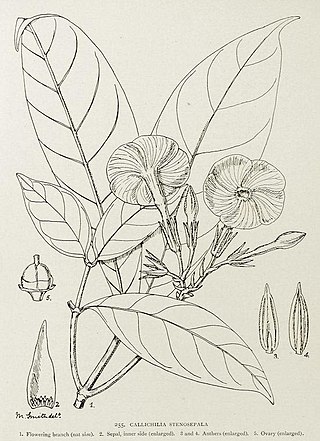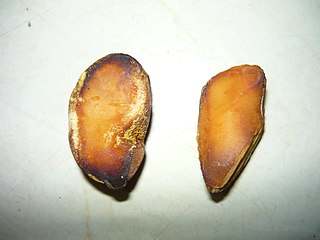
Panda is a plant genus of the family Pandaceae. It contains only one known species, Panda oleosa, native to western and central Africa.
Crotonogyne is a shrub of the spurge family (Euphorbiaceae) first described as a genus in 1864. It is native to western and central Africa. It is dioecious.
Dichostemma is a flowering plant genus in the family Euphorbiaceae first described as a genus in 1896. It is native to tropical western and central Africa.
- Dichostemma glaucescensPierre - Nigeria, Cameroon, Gabon, Republic of the Congo, Central African Republic, Cabinda, Democratic Republic of the Congo
- Dichostemma zenkeriPax - Cameroon

Maprounea is a plant genus of the family Euphorbiaceae first named as a genus in 1775. It is native to tropical Africa, Trinidad, and tropical Central and South America.
- Maprounea africana - W + C + S Africa, from Benin to Zimbabwe
- Maprounea amazonica - Colombia, Venezuela, N Brazil
- Maprounea brasiliensis - Brazil, Paraguay, Bolivia
- Maprounea guianensis - Trinidad, Panama, Colombia, Venezuela, French Guiana, Suriname, Guyana, Brazil, Peru, Ecuador, Bolivia, Paraguay
- Maprounea membranacea - Nigeria, Cameroon, Gabon, Equatorial Guinea, Cabinda, Central African Republic, Congo, Zaire
Plagiostyles is a plant genus in the family Euphorbiaceae first described as a genus in 1897. It is native to tropical Africa.
- Plagiostyles africana(Müll.Arg.) Prain - Nigeria, Cameroon, Gabon, Cabinda Province, Angola, Equatorial Guinea, Republic of the Congo, Democratic Republic of the Congo
- Plagiostyles pinnatusWilld. - Gabon

Thomandersia is the sole genus in the Thomandersiaceae, an African family of flowering plants. Thomandersia is a genus of shrubs and small trees, with six species native to Central and West Africa.
Eremospatha is a genus of climbing flowering plants in the palm family found in tropical Africa. These rattans are uncommon in cultivation and poorly understood by taxonomists. Closely related to Laccosperma, they are differentiated by the near complete absence of bracts and bracteoles. The name is from Greek meaning "without a spathe".
Podococcus is a genus of palms found in tropical Africa. It includes two recognized species:

Puelia is a genus of African grasses, the only genus in the tribe Atractocarpeae. It belongs to the subfamily Puelioideae, one of the early-diverging lineages in the grasses, but used to be considered a bamboo genus.
Cuviera is a genus of flowering plants in the family Rubiaceae native to tropical Africa. It was originally described by Augustin Pyramus de Candolle in 1807 and is named after the French naturalist Georges Cuvier.
Brenania is a genus of flowering plants in the family Rubiaceae. It is found from Nigeria to Cameroon, Gabon, Cabinda, Central African Republic, Congo, and D.R.Congo. The genus was described in 1958 and contained only the type species Brenania spathulifolia.

Craterispermum is a genus of flowering plants in the family Rubiaceae. It contains 16 species that occur in tropical Africa and Seychelles. It is the only genus in the tribe Craterispermeae, of which the divergence time is estimated at 34.8 million years ago.

Callichilia is a genus of plant in the family Apocynaceae, native to tropical Africa.

Pleiocarpa is a genus of plant in the family Apocynaceae first described as a genus in 1876. It is native to tropical Africa from Senegal to Tanzania and south to Zimbabwe. As of August 2013 the World Checklist of Selected Plant Families recognises 6 species:
- Pleiocarpa bicarpellataStapf - Cabinda, Cameroon, Republic of the Congo, Gabon, Democratic Republic of the Congo, Kenya
- Pleiocarpa brevistylaOmino - Gabon
- Pleiocarpa muticaBenth. - Ghana, Ivory Coast, Liberia, Sierra Leone, Nigeria, Cameroon, Gabon, Central African Republic, Republic of the Congo
- Pleiocarpa picralimoides(Pichon) Omino - Cabinda, Republic of the Congo, Gabon
- Pleiocarpa pycnantha(K.Schum) Stapf - widespread across most of tropical Africa
- Pleiocarpa rostrataBenth. - Nigeria, Cameroon, Gabon
- Pleiocarpa camerunensis(K.Schum. ex Hallier f.) Stapf = Hunteria camerunensisK.Schum. ex Hallier f.
- Pleiocarpa hockiiDe Wild. - Acokanthera oppositifolia(Lam.) Codd
- Pleiocarpa simii(Stapf) Stapf ex Hutch. & Dalziel = Hunteria simii(Stapf) H.Huber

Englerophytum is a group of trees in the family Sapotaceae described as a genus in 1914.

Haumania is a genus of flowering plants in the family Marantaceae. It is native to central Africa. As of March 2022, Kew and Plants of the World Online accepts three species:

The genus Barteria is in the family Passifloraceae in the major group angiosperms. It contains 8 described species, however, only 6 are accepted.
Orthopichonia is a genus of plants in the family Apocynaceae, first described as a genus in 1953. It was initially given the name Orthandra, but this turned out to be an illegitimate homonym. Orthopichonia is native to Africa.

Simaba is a genus of flowering plants belonging to the family Simaroubaceae.
Gambeya is a genus of flowering plants belonging to the family Sapotaceae.










